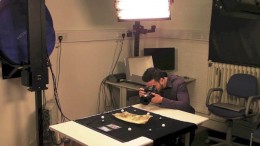Great Parchment Book retrospective: imaging
Next » « PreviousIn our previous post in this occasional series reflecting on the different elements which make up the Great Parchment Book project we looked at conservation; now it’s the turn of digital imaging.
It had been evident for many years that traditional conservation alone would not produce sufficient results to make the Great Parchment Book accessible, although there had been at least one attempt in the past. Following discussions with conservation and imaging experts, it was decided to flatten the parchment sheets as far as possible appropriate to their fragile state to enable digital imaging with the ultimate aim of reconstructing the manuscript digitally. We knew from the first that this was an undertaking without a certain result as we were committed to exploring new techniques and technologies; nothing else had any chance of success.
A partnership with UCL established a four year Engineering Doctorate in the Virtual Environments, Imaging and Visualisation programme in September 2010 (jointly funded by the Engineering and Physical Sciences Research Council and LMA) with the intention of developing software that would make the distorted text legible. The doctoral student, Kazim Pal, was supervised by Melissa Terras, Director of the UCL Centre for Digital Humanities and Professor of Digital Humanities in the Department of Information Studies at University College London and Tim Weyrich, Professor of Visual Computing in the Virtual Environments and Computer Graphics group in the Department of Computer Science, University College London and Deputy Director of the UCL Centre for Digital Humanities.
During the digitisation phase, which in part ran alongside the conservation, a set of images was captured for each page and used to generate 3D models. Ground-breaking software was developed to allow these models to be flattened and browsed virtually.
 Kazim’s work was more successful than we could have hoped with the digitally flattened images of the folios featuring on the dedicated Great Parchment Book website alongside a transcript making the Great Parchment Book available for consultation by researchers once more.
Kazim’s work was more successful than we could have hoped with the digitally flattened images of the folios featuring on the dedicated Great Parchment Book website alongside a transcript making the Great Parchment Book available for consultation by researchers once more.
The digitisation of the Great Parchment Book was recognised in 2014 when the project received a European Succeed Award (for digitisation focussing on textual content) Commendation of Merit.
You can explore the digital imaging of the Great Parchment Book in detail on the blog (go to the end of the page once you’ve clicked the link to read in chronological order).
See also the UCL project web page which includes access to the free software produced in the course of the project and the amazing video of the flattening software in action.
We also continue to highlight other developments which are revolutionising access to archives through the use of new technology and innovation on the blog.
